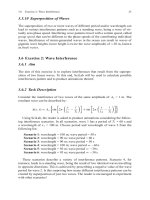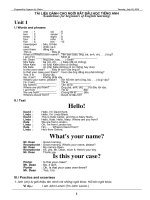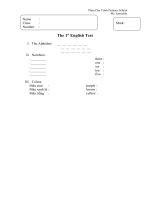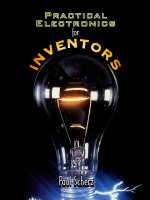Electronics for beginners
Bạn đang xem bản rút gọn của tài liệu. Xem và tải ngay bản đầy đủ của tài liệu tại đây (2.58 MB, 477 trang )
basic electronic design build and test for beginners students teachers hobbyists
ELECTRONICS FOR BEGINNERS
AND
INTERMEDIATE ELECTRONICS
2001
[04/07/2002 09:18:04]
basic electronic design build and test for beginners students teachers hobbyists
My name is Graham Knott and I teach Electronics and
Microcomputing at Cambridge Regional College, situated
in the University City of Cambridge, England.
I hope that you find this website useful.
This complete website, plus other information, is available on a CD.
Search
Copyright Graham Knott 2001
[04/07/2002 09:18:08]
neworder
You can buy this complete website on a CD.
Other software is included on the CD,
Circuit Symbols
PCB designer
Logic Gate simulator
Z80 Microprocessor simulator
Photos of components
American Wire Gauges
The price is ten pounds in the UK, which includes postage.
The CD can also be posted anywhere else in the world for
fifteen American dollars. This includes all mailing charges.
Please trust me and send the money in bills. UK banks
charge too much to change foreign money checks.
You will need a browser to view the web pages. Internet
Explorer and Netscape Navigator have been included on
(1 of 2) [04/07/2002 09:18:11]
neworder
the CD.
Please send your order to the following address.
Graham Knott
27, Edinburgh Road
Cambridge
CB4 1QR
UK
phone 01223 502751
Copyright Graham Knott 2000
(2 of 2) [04/07/2002 09:18:11]
template
ELECTRONICS FOR BEGINNERS
CLICK HERE TO BUY THE CD
GENERAL THEORY
PRACTICAL SKILLS and PROJECTS
COMPONENTS
TEST AND MEASUREMENT
DIGITAL
D.C. THEORY
BLOCK DIAGRAMS
Copyright Graham Knott 1999
[04/07/2002 09:18:11]
basic electronic design build and test for beginners students teachers hobbyists
GENERAL THEORY
CLICK HERE TO BUY THE CD
THE DIFFERENCE
AMPLIFIER
CIRCUIT SYMBOLS
REACTANCE AND
IMPEDANCE
FEEDBACK
CIRCUIT DIAGRAMS
CONDUCTORS AND
INSULATORS
PULSES
GRAPHS AND
WAVEFORMS
TIME CONSTANTS
SOURCE AND LOAD
RMS AND PEAK TO
PEAK
FILTERS
THE INTEGRATOR
THE GENERATOR
PRINCIPLE
THE DIFFERENTATOR
ELECTROMAGNETISM
THE R.F. SPECTRUM
MAGNETISM
THE MOTOR PRINCIPLE
AMPLIFIERS
CLIPPERS AND LIMITERS
OSCILLATORS
WHAT IS PHASE
LIGHT
FREQUENCY
MODULATION
HARMONICS
SOUND
AMPLITUDE MODULATION
THE MIXER
THE FREQUENCY CHANGER
PULSE MODULATION
AVERAGES
SEMICONDUCTOR
MATERIALS
PERCENT AND TOLERANCE
HEAT
Copyright Graham Knott 1999
[04/07/2002 09:18:13]
basic electronic design build and test for beginners students teachers hobbyists
COMPONENTS
CLICK HERE TO BUY THE CD
RESISTOR COLOUR
CODE
VALUE MULTIPLIERS
WIRES AND CABLES
PRINTED CIRCUIT
BOARDS
THE DIODE
INTEGRATED CIRCUITS
FUSES
SWITCHES
7 SEGMENT DISPLAYS
BATTERIES
CIRCUIT SYMBOLS
INDUCTORS
THE TRANSFORMER
USING LED's
RESISTORS
CAPACITORS
THE CRT
TRANSFORMER TYPES
ACTIVE AND PASSIVE
THE ELECTROMAGNETIC RELAY
THE LOUDSPEAKER
SEMICONDUCTOR DATA
COMPONENT
SUPPLIERS
AMERICAN WIRE GAUGES 2
SELECTING
CAPACITORS
AMERICAN WIRE
GAUGES 1
Copyright Graham Knott 1999
[04/07/2002 09:18:15]
THE REED SWITCH
basic electronic design build and test for beginners students teachers hobbyists
TEST AND
MEASUREMENT
LOGICAL FAULT FINDING
MEASURING VOLTAGES
MEASURING CURRENT
FREQUENCY RESPONSE
SIGNAL GENERATORS
TESTING TRANSISTORS
CONTINUITY TESTING
EFFECT OF METER
RESISTANCE
WITH RESPECT TO
MEASURING RESISTANCE
USING A SCOPE
TRACING A SCHEMATIC
FAULT FINDING
ALGORITHMS
Copyright Graham Knott 1999
[04/07/2002 09:18:17]
basic electronic design build and test for beginners students teachers hobbyists
DIGITAL
CIRCUITS
CLICK HERE TO BUY THE CD
LOGIC GATES
AND GATES
OR GATES
MULTIVIBRATORS
NOT GATES
EXCLUSIVE OR
NOR GATES
BINARY
NAND GATES
BISTABLE AS DIVIDER
THE 7490 DECADE COUNTER
BINARY/7 SEGMENT DECODER
HEXADECIMAL
Copyright Graham Knott 1999
[04/07/2002 09:18:21]
basic electronic design build and test for beginners students teachers hobbyists
CLICK HERE TO BUY THE CD
DC THEORY
WHAT IS ELECTRIC CURRENT
CURRENT IN CIRCUITS SERIES/PARALLEL BATTERIES
OHM'S LAW
RESISTORS IN SERIES
RESISTORS IN PARALLEL
POTENTIAL DIVIDERS
WATTS AND JOULES
RESISTOR NETWORKS
VOLTAGES IN A CIRCUIT
THE WHEATSTONE BRIDGE
Copyright Graham Knott 1999
[04/07/2002 09:18:23]
basic electronic design build and test for beginners students teachers hobbyists
CLICK HERE TO BUY THE CD
BLOCK DIAGRAMS
BLOCK DIAGRAMS
DC MOTOR SPEED CONTROL
THE DIGITAL CLOCK
THE TAPE RECORDER
THE AM TRANSMITTER
THE A.M. RECEIVER
THE F.M. TRANSMITTER
THE F.M. RECEIVER
THE OSCILLOSCOPE
POWER SUPPLY UNITS
MONO T/V CAMERA
COLOUR T/V CAMERA
THE COMPUTER
THE PHASE LOCKED LOOP
MONO T/V RECEIVER
Copyright Graham Knott 2001
[04/07/2002 09:18:24]
template
INTERMEDIATE ELECTRONICS
CLICK HERE TO BUY THE CD
THE DIODE
THE JUNCTION TRANSISTOR
TRANSISTOR FAULT FINDING
THE UNIJUNCTION TRANSISTOR
THE FIELD EFFECT TRANSISTOR
THE OPERATIONAL AMPLIFIER (OPAMP)
BELS, DECIBELS AND dB
THE THYRISTOR, TRIAC AND DIAC
MULTIVIBRATORS
THE SCHMITT TRIGGER 1
THE SCHMITT TRIGGER 2
REACTANCE AND IMPEDANCE IN AC
CIRCUITS
PHASORS AND RESONANCE
MICROPROCESSOR SYSTEMS
COMBINATIONAL LOGIC
FLIP-FLOPS
SEQUENTIAL LOGIC
Copyright Graham Knott 1999
[04/07/2002 09:18:25]
template
THE DIODE
CLICK HERE TO BUY THE CD
INTRODUCTION TO DIODES
SEMICONDUCTOR MATERIALS
THE P-N JUNCTION
THE BARRIER
THE FORWARD BIASED JUNCTION
THE REVERSE BIASED JUNCTION
FORWARD AND REVERSE BIASED
DIODES
A DIODE PUZZLE
DIODE VOLTAGES
DIODE CHARACTERISTIC CURVES
DIODE CONNECTIONS
THE HALF WAVE RECTIFIER
THE RESERVOIR CAPACITOR
THE FULL WAVE RECTIFIER
THE VOLTAGE DOUBLER
DIODE CLIPPERS AND LIMITERS
THE STEERING DIODE
THE DIODE AS A GATE
USING THE LIGHT EMITTING DIODE
THE SEVEN SEGMENT DISPLAY
THE ZENER DIODE
THE VARICAP DIODE
DIODE PROTECTION CIRCUITS
Copyright Graham Knott 1999
[04/07/2002 09:18:27]
index2
THE JUNCTION TRANSISTOR
CLICK HERE TO BUY THE CD
THE JUNCTION TRANSISTOR
JUNCTION TRANSISTOR BIASING
TRANSISTOR OPERATION
THE TRANSISTOR AS A SWITCH
CLASS A, B AND C BIAS
THE TRANSISTOR SMALL SIGNAL
AMPLIFIER
BIASING A TRANSISTOR
THE EMITTER STABILISER RESISTOR.
THE LOAD RESISTOR
TYPICAL CIRCUIT VALUES
AMPLIFIERS IN CASCADE
THE TUNED AMPLIFIER
THE COMMON EMITTER AMPLIFIER
THE COMMON BASE AMPLIFIER
THE COMMON COLLECTOR AMPLIFIER
THE PHASE SPLITTER
THE CLASS A POWER AMPLIFIER
THE PUSH-PULL AMPLIFIER
THE COMPLEMENTARY PUSH-PULL
AMPLIFIER PART 1
THE COMPLEMENTARY PUSH-PULL
AMPLIFIER PART 2
THE DIRECTLY COUPLED AMPLIFIER
THE DARLINGTON PAIR
Copyright Graham Knott 1999
[04/07/2002 09:18:28]
index10
TRANSISTOR FAULT FINDING
CLICK HERE TO BUY THE CD
UPPER BASE BIAS RESISTOR O/C
LOWER BASE BIAS RESISTOR O/C
COLLECTOR LOAD RESISTOR O/C
EMITTER RESISTOR O/C
EMITTER CAPACITOR S/C AND O/C
Copyright Graham Knott 1999
[04/07/2002 09:18:29]
unijunction
THE UNIJUNCTION TRANSISTOR
CLICK HERE TO BUY THE CD
The unijunction transistor (UJT) is made of a bar of N type
material with a P type junction (the emitter) near the centre.
Base 1 is connected to zero volts and base 2 to the positive
supply.
The resistance between the two bases (the INTERBASE
RESISTANCE) is typically 10k.
With the emitter unconnected, the bar acts as a potential
divider, and about 0.5 volts appears at the emitter.
If a voltage is connected to the emitter, as long as it is less
than 0.5 volts, nothing happens, as the P-N junction is
reversed biased. (see the right hand diagram).
When the emitter voltage exceeds 0.5 volts, the junction is
forward biased and emitter current will flow.
(1 of 3) [04/07/2002 09:18:31]
unijunction
This increase in current is equal to a reduction of resistance
between base 1 and the emitter.
This causes the emitter voltage to fall.
In the circuit, C charges via R1.
When the voltage across C exceeds 0.6 volts, the b1/emitter
junction goes low resistance and discharges C.
The result is a sawtooth waveform across C.
There is also a pulse of current through R3 , giving a pulse of
voltage across it.
This circuit is called a relaxation oscillator.
The voltage across C charges up slowly then suddenly
relaxes.
The circuit is often used to trigger thyristor circuits.
(2 of 3) [04/07/2002 09:18:31]
unijunction
Copyright Graham Knott 1999
(3 of 3) [04/07/2002 09:18:31]
template
FIELD EFFECT TRANSISTORS
CLICK HERE TO BUY THE CD
THE JUNCTION FET
THE JUNCTION FET AS AN AMPLIFIER
THE MOSFET
MOSFET CIRCUIT SYMBOLS
Copyright Graham Knott 1999
[04/07/2002 09:18:32]
index12
THE OPERATIONAL AMPLIFIER
CLICK HERE TO BUY THE CD
THE BASIC OPAMP
OPAMP CHARACTERISTICS
SETTING OPAMP GAIN
UNITY GAIN NON INVERTER
NON INVERTER WITH GAIN
THE COMPARATOR
TEMPERATURE ALARM
THE OPAMP AS A TIMER
THE OPAMP AS AN AUDIO MIXER
OPAMP DUAL POWER SUPPLIES
Copyright Graham Knott 1999
[04/07/2002 09:18:33]
decibels
BELS, DECIBELS AND dB
CLICK HERE TO BUY THE CD
Bels are a means of comparing two powers or two voltages.
For example, comparing the power input to an amplifier with
the power output as in the diagram below.
The ratio of power in, to power out, is the power gain.
In the next diagram, we have three stages of amplification.
To find the overall power gain, we multiply the individual gains.
10 X 6.5 X 9.2 = ?
Multiplying is not friendly and also large numbers can result.
(1 of 4) [04/07/2002 09:18:36]
decibels
If we find the log of the power ratio, the answer is in Bels.
To do this, we work out the power ratio and then look up the
log of this value in log tables.
Since Bels are too big , we work in decibels (dBs) as shown
below.
One advantage of decibels are that the numbers are usually
more convenient.
Below, the overall gain is 1,000,000,000 or +90 dBs.
A gain of 1000 is +30 dB.
To find the overall gain, individual gains are added.
The + sign indicates a gain.
A
- sign would indicate an attenuation.
(2 of 4) [04/07/2002 09:18:36]
decibels
If we are using voltage ratios then use the following formula.
The ear has a logarithmic response.
To make your amplifier sound twice as loud you must boost
the power by 10 times. (+10 dB)
If you only double the power (+3 dB), then you will only just be
able to detect the increase in volume.
Other points: there is always a ratio, such as the noise of
Concorde compared with the noise of rustling leaves.
Sometimes there are standard levels to be compared with,
such as 1 mW into 600 ohms for audio, or 1 volt into 75 ohms
for video.
10 dBm, for example, is +10 dB relative to 1 mW.
(3 of 4) [04/07/2002 09:18:36]
decibels
It is not necessary to do calculations, tables are available,
giving the dB equivalent of ratios, and vice-versa.
A useful table is shown below.
A gain of 400 watts is 2 x 2 x10 x 10 which is 3 dB + 3 dB + 10
dB + 10 dB = +26 dB.
A voltage gain of + 52 db = 20dB + 20 dB + 6 dB + 6 dB which
is 10 x 10 x 2 x 2 = a gain of 400 times.
Copyright Graham Knott 1999
(4 of 4) [04/07/2002 09:18:36]
index13
THE THYRISTOR, TRIAC AND DIAC
CLICK HERE TO BUY THE CD
THE THYRISTOR
BURST TRIGGERING THE THYRISTOR
PHASE TRIGGERING THE THYRISTOR
FULL WAVE CONTROL OF THE
THYRISTOR
THE TRIAC AND DIAC
THE THYRISTOR AS A CROWBAR
Copyright Graham Knott 1999
[04/07/2002 09:18:37]









